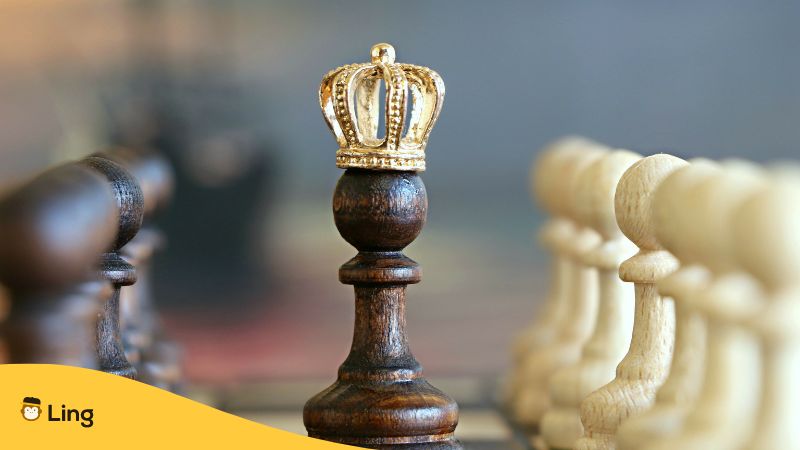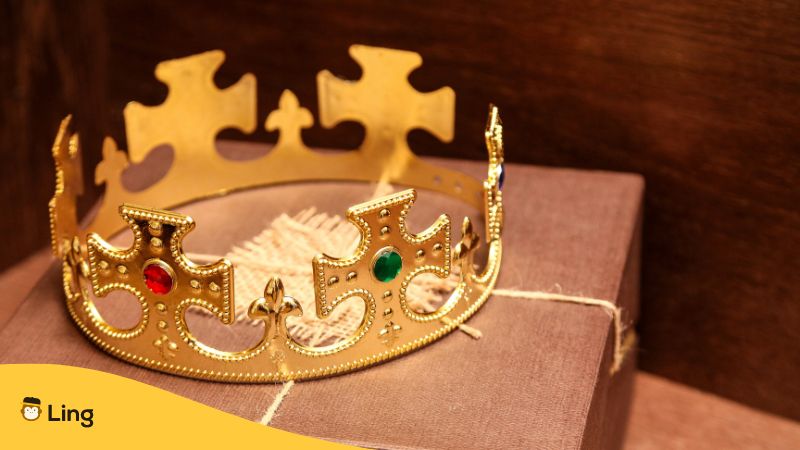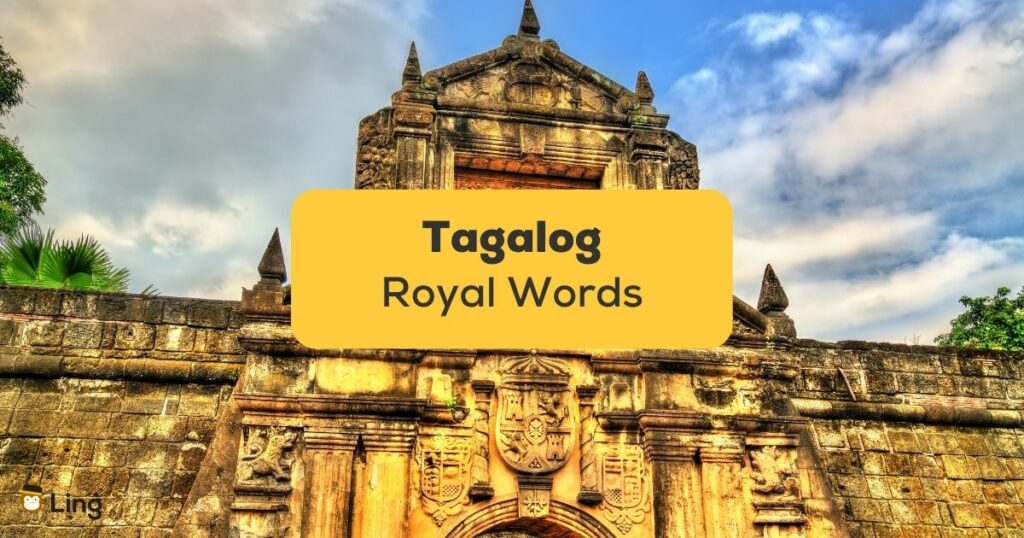Dreaming of spicing up your language skills with a dash of Tagalog royal words? Well, you’re in luck because this post will help you get to know all the words related to all things king and queen! From the historical roots of these noble titles to their use in the modern-day Philippines, we’ve got it all covered for you! Let’s begin!
So you’ve been scrolling through your mental Rolodex of Asian monarchies – the Japanese emperors, the Thai kings, the Bruneian sultans, and you can’t help but wonder, where’s the royal Filipino bloodline? Well, dear reader, here’s the tea: the Philippines, unlike many of its Asian counterparts, didn’t have kings or queens, at least not in the way we typically understand them.
Plot twist, right?
But wait, before you go scratching your head about those earlier mentions of a king (or hari) and queen (or reyna), let’s delve into the nitty-gritty of this unique facet of Filipino history.
Traditionally, the Philippines was not a unified kingdom but a collection of independent ‘barangays‘ or ‘datuships.’ Each of these was led by a ‘datu‘ or a chieftain, sort of like the big boss of the community but not quite a king. While the ‘datu’ was definitely a prominent figure wielding a considerable amount of power and influence, they weren’t absolute rulers draped in velvet cloaks and shiny crowns.
Each place in the country back then was governed by the datu, along with a council of elders. These elders are involved in decision-making and problem-solving scenarios. So technically, it’s a democracy with a hint of royal charm, don’t you think?
So, while you might not find a Filipino king or queen on a glossy postcard of Asian monarchs, the Philippines has a unique and equally fascinating structure of traditional leadership. It’s a blend of homegrown customs and external influences, a testament to the Philippines’ rich cultural and historical tapestry.
Curious and willing to learn more? Read the sections below!

Tagalog Words For Royal Titles
Peel back the curtains, roll out the red carpet, and get ready for a linguistic royal procession. We’ve been talking a lot about Tagalog royal terms, but it’s high time we put some of these words under the spotlight. Whether you’re a linguaphile, a history buff, or just someone fascinated by words with a royal ring to them, you’re in for a treat!
Below, you’ll find a handy table listing common English royal titles and their Tagalog counterparts. Bear in mind, though, that cultural differences mean some titles won’t have an exact match in Tagalog. But that’s part of the fun – discovering how different languages express similar concepts!
| English | Tagalog |
|---|---|
| King | Hari |
| Queen | Reyna |
| Prince | Prinsipe |
| Princess | Prinsesa |
| Monarch | Monarka |
| Noble | Mahal na tao |
| Ruler | Tagapamahala |
Monarchy In The Philippines
Imagine a grand ballroom decked out with shimmering chandeliers, walls echoing with orchestral music, and figures clad in satin gowns or tailored tuxedos waltzing across the dance floor. This might be a typical scene in royal palaces across Europe but in the Philippines? Not quite.
Technically, the Philippines doesn’t have a monarchy or monarkiya in the sense of hereditary rulers or an established line of kings and queens reigning over the country. Instead, it has a unique and complex system of traditional leadership roles woven through its history.
Pre-Colonial Period
As we mentioned earlier, pre-colonial Philippines was a patchwork of independent ‘barangays’ or ‘datuships,’ each led by a ‘datu.’ These leaders, while influential and respected, were not kings or queens. They didn’t wield absolute power or rule over large territories but instead led their communities in consultation with councils of elders.
In several parts of the country, particularly in the coastal areas and river deltas where trade flourished, the Filipinos also have leaders called ‘Rajas.’ In many ways, ‘Rajas’ functioned similarly to the ‘Datus,’ but with a little extra sparkle. They were typically the rulers of larger territories or powerful city-states known as ‘Kedatuans,’ ‘Rajahnates,’ or ‘Sultanates.’ Notable examples include the Rajahnates of Butuan and Cebu and the Sultanate of Sulu.
Back in the day, a Raja was considered a paramount ruler, meaning they held higher prestige and authority compared to a Datu. The position was hereditary and usually passed on to the eldest son. While they didn’t sit on golden thrones in towering castles, the Rajas did enjoy privileges and commanded respect from their people. They led in making key decisions, protected their communities, and maintained trade relations with other regions.
Interestingly, the concept of ‘Raja’ wasn’t unique to the Philippines. The title had its roots in the Indian subcontinent and was spread across Southeast Asia through the influence of Indian culture and trade. While the specifics may vary from region to region, ‘Raja’ generally denotes a monarch or ruler in many Asian societies.
Spanish Period
With the arrival of the Spanish in the 16th century, the landscape of leadership changed. The Spanish introduced the concept of the ‘principalía,’ a class of noble Tagalogs who were recognized for their lineage, wealth, or contributions to their communities. The ‘principalía’ played a key role in local governance during the colonial period, acting as go-betweens for the Spanish authorities and the local population.
Modern Philippines
In modern times, while there are no officially recognized royal families or titles, there are groups and individuals in the Philippines who claim such status. Many of these claims are based on historical lineage or assertions of traditional leadership roles, particularly among the country’s Indigenous communities. However, these claims are often the subject of debate and are not officially recognized by the Philippine government.
So, does the Philippines have royalty?
In a sense, yes, it has a rich history of traditional leadership roles that echo some aspects of royalty. However, these roles are unique to the cultural and historical context of the Philippines and are quite different from the typical concept of kings and queens.
So, while you may not see a Filipino king or queen gracing the balcony of a grand palace, remember that the Philippines has its own unique version of ‘royalty,’ firmly rooted in its rich history and cultural traditions. And in many ways, isn’t that even more fascinating?

Other Tagalog Royal Words
Now that you already know the royal titles, let’s expand your vocab further! Afterall, the world of Tagalog royal lingo is richer than a treasure trove in a hidden castle. Beyond the basic titles, there are other words related to royalty and governance that offer a peek into the unique cultural and historical nuances of the Philippines.
These words paint a picture of life, order, and authority in both pre-colonial and colonial Philippines, serving as linguistic bridges to a past marked by a blend of indigenous traditions and foreign influences. Below, we’ve curated a list of additional royal-related Tagalog words paired with their English translations. So, put on your linguistic explorer hat, and let’s dive in!
| English | Tagalog |
|---|---|
| Throne | Trono |
| Crown | Korona |
| Palace | Palasyo |
| Kingdom | Kaharian |
| Rule | Pamamahala |
| Power | Kapangyarihan |
| Sovereignty | Kasarinlan |
| Noble | Maharlika |
| Dynasty | Angkan |
| Reign | Panunungkulan |
So, there you have it! A feast of words for your linguistic palate! Remember, language is a reflection of culture and history, so each of these words is more than just a Tagalog translation. It’s a gateway to understanding the rich tapestry of Filipino society, both past and present. Don’t be shy to use them, and, most importantly, have fun exploring!
Learn Tagalog Through Ling
If this journey through Tagalog royal vocabulary has sparked a fire in your linguistic heart, we’ve got some fantastic news for you: the adventure is far from over! By this point, you’ve dipped your toes in the rich waters of the Tagalog language, but there’s a whole ocean out there waiting for you to explore.
Ready to dive deeper into the fascinating world of Tagalog? Want to expand your vocabulary beyond the realm of royalty, perhaps into everyday phrases or deep-cut slang that will make you sound like a local? If the answer is a resounding “Yes!”, then it’s time to try the Ling.
Ling is an incredible tool that’s perfect for anyone looking to learn Tagalog at their own pace, whether you’re a beginner just starting your linguistic journey or an intermediate learner hoping to brush up on your skills. With a wide range of lessons, exercises, and resources, Ling makes language learning interactive, engaging, and, most importantly, fun!
So what are you waiting for? Download it today for FREE from the App Store or Play Store to get started!































































